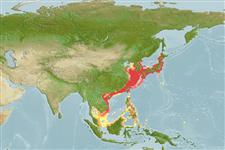Common names from other countries
Environment: milieu / climate zone / depth range / distribution range
Ökologie
seewasser demersal; ozeanodrom (Ref. 51243); tiefenbereich 10 - 200 m (Ref. 11230). Subtropical; 62°N - 1°N, 99°E - 163°E (Ref. 54698)
Western Pacific: Japan, Sakhalin, Kuril Islands, Korean Peninsula to the South China Sea.
Length at first maturity / Size / Gewicht / Alter
Maturity: Lm ?, range 40 - ? cm
Max length : 103 cm TL Männchen/unbestimmt; (Ref. 40637); max. veröff. Gewicht: 9.1 kg (Ref. 40637)
Rückenflossenstacheln (insgesamt): 0; Rückenflossenweichstrahlen (insgesamt): 77-81; Afterflossenstacheln 0; Afterflossenweichstrahlen: 59 - 61; Wirbelzahl: 38
Most highly prized of the Japanese flounders.
Distinct pairing (Ref. 205).
Masuda, H., K. Amaoka, C. Araga, T. Uyeno and T. Yoshino, 1984. The fishes of the Japanese Archipelago. Vol. 1. Tokai University Press, Tokyo, Japan. 437 p. (text). (Ref. 559)
IUCN Rote Liste Status (Ref. 130435)
CITES (Ref. 128078)
Not Evaluated
Bedrohung für Menschen
Harmless
Nutzung durch Menschen
Fischereien: hoch kommerziell; Aquakultur: kommerziell
Tools
Zusatzinformationen
Download XML
Internet Quellen
Estimates based on models
Preferred temperature (Ref.
115969): 8.6 - 25, mean 18.8 (based on 241 cells).
Phylogenetic diversity index (Ref.
82804): PD
50 = 0.5000 [Uniqueness, from 0.5 = low to 2.0 = high].
Bayesian length-weight: a=0.00794 (0.00438 - 0.01441), b=3.07 (2.90 - 3.24), in cm Total Length, based on LWR estimates for this species & (Sub)family-body (Ref.
93245).
Trophic level (Ref.
69278): 4.5 ±0.8 se; based on diet studies.
Widerstandsfähigkeit (Ref.
120179): mittel, Verdopplung der Population dauert 1,4 - 4,4 Jahre. (tm=3; Fec= 3 million).
Fishing Vulnerability (Ref.
59153): High vulnerability (60 of 100).
Climate Vulnerability (Ref.
125649): Moderate vulnerability (43 of 100).
